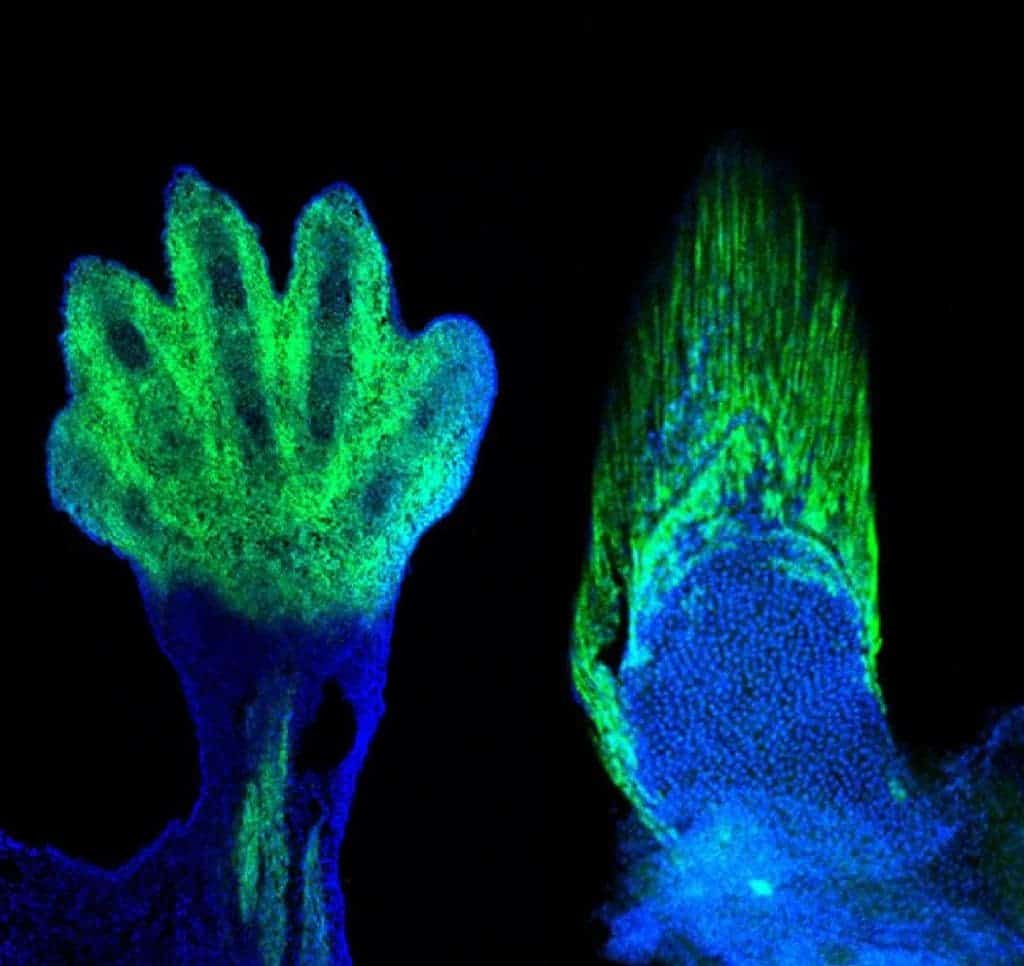
Using CRISPR, a gene editing tool that can work like a scissor to cut genes from the genome, University of Chicago researchers proved our beloved hands are coded by the same genes that make fish fins.
Water to land — different needs, same blueprint
At first glance, there aren’t that many similarities between a human hand and a fish’s fin, apart from both being protruding extremities. If we’re to remove the skin and muscles, we’ll see the human hand is made from bones which grew from cartilage and contain blood vessels — this sort of tissue is called enchondral bone. A fish, such as a zebrafish, has endochondral bones too but these appear only at the base of the fin. From here, the similarities end because the rest of the fin is made of thin rays composed of a different kind of tissue called dermal bone, which doesn’t start out as cartilage and doesn’t contain blood vessels.
There’s reason to believe, however, that all hands, paws, hoofs, wings and afferent digits diverged from the ray-fins of a common aquatic ancestor some 430 million years ago. Only after four-limbed creatures, the tetrapods, first landed on the continents did nature worked its magic — and you can now create just about anything with those wonderful five digits, and especially talented thumb.
So goes the theory, and we have a treasure trove of fossils to prove this is how the transition went. It remained unclear, however, how the terminal ends of fish and tetrapods, such as humans, are related and consequently how digits developed. Are our hands the product of a new evolutionary process or are they merely following the fin genetic lineage? Most scientists hang to the former.
For two decades, evolutionary biologist Neil Shubin and colleagues at the University of Chicago have been studying this transition. Shubin’s work is very familiar to experts in the field and he is among those who first showed that an ancient 370-million-year old fish had limb-like fins. In 1996, he and his colleagues were startled when a group of French researchers found two genes called Hoxa13 and Hoxd13 which when switched off in mice caused the rodents to grow only stubs — no hands, no digits. This was incredibly exciting because life-long experience and study told Shubin that fish must have these gene counterparts nestled somewhere that code the development of fins. He didn’t have the means to manipulate these genes though — not until technology caught up and CRISPR entered the picture.
CRISPR-Cas9 is a unique technology that enables geneticists and medical researchers to edit parts of the genome by cutting out, replacing or adding parts to the DNA sequence. The technology is so powerful that scientists can use it to cut out HIV genes from live animals, and even engineer superhumans, which has caused quite a stir.
Using CRIPR, Shubin’s lab inserted bits of DNA into the Hoxa-13 and Hoxd-13 genes of zebrafish — a model animal often used in genetic research because its embryos are transparent and development can easily be tracked. To monitor what they were doing, the team also used a special technique that adds glowing red molecules to any cell that activates Hoxa13. When this is done on mice, only the cells that go on to grow the wrist glow — cells which eventually turn into the bones that form the hand and digits.
Before the zebrafish experiment, the researchers believed that hands and digits did not evolve from fin rays because the two are made of different bones. But when Andrew R. Gehrke, a graduate student, showed his results, Shubin was dumbstruck — the fin rays glow red and kept glowing until they reached their final location in the fish’s body.
“Here we’re finding that the digits and the fin rays have some sort of equivalence at the level of the cells that make them,” Dr. Shubin told the New York Times. “Honestly, you could have knocked me over with a feather — it ran counter to everything that I was expecting after working on this problem for decades.”
The findings published in Nature essentially mean that hands and fins follow the same development rules. It means that our hands and digits aren’t evolutionary novelties. Instead, they were built from the same hundreds-of-millions-of-years-old blueprint that had been making fins since times immemorable.
“It’s not saying that fin rays and digits are the same thing,” emphasizes Kimberley Cooper from the University of California, San Diego, told The Atlantic. “But there was so much talk about how they are different, and at a fundamental ancient level they’re more similar than we appreciated.”
“It shows us how bodies are built,” says Shubin. “By understanding the biology of fish, we understand the basic architecture of our bodies, and how genes and cells interact to build us, and how we evolve.”






